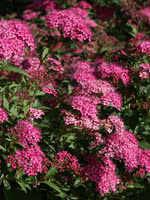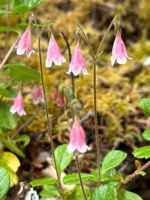Mon-Fri 9am - 5pm Mountain time
Anthony Waterer Spiraea vs Twinflower
Spiraea japonica Anthony Waterer
Linnaea borealis
CUSTOM GROW
CUSTOM GROW
Anthony Waterer Spiraea is a low maintenance shrub with a dwarf, rounded form. In spring and summer rosy pink blooms emerge against green foliage. Its tolerance of a variety of well-drained soils makes it an ideal foundation, landscaping, or border plant.
If deer and rabbit are an issue on your property, consider planting Anthony Waterer Spiraea for its deer/rabbit resistance. Due to its compact form, minimal pruning is required.
Twinflower is a native, trailing evergreen ground cover known for its delicate flowers that grow in nodding pairs. These pale pink blooms are described as being sweetly fragrant, attracting native bees and other pollinators.
Growing in cool, moist, acidic soils, the trailing stems form roots as they spread and start to form mats across the forest floor. Due to its woody stem, it is technically classified as a shrub and often referred to as a subshrub or dwarf shrub. This species is well-suited for naturalization, restoration, and conservation projects.
Twinflower (Linneae borealis) was named in honour of Carl Linnaeus, who adopted it as his personal emblem.

